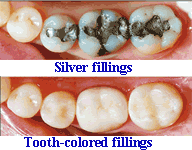Oral Health Topics

FILLINGS
Fillings, known clinically as amalgams, are synthetic materials that are used to restore a portion of a tooth damaged by decay or traumatic injury. There are different types of materials used to fill cavities, including gold and metal alloys.
Dental amalgam (silver filling) is considered a safe, affordable and durable material that has been used to restore the teeth of more than 100 million Americans. It contains a mixture of metals such as silver, copper and tin, in addition to mercury, which chemically binds these components into a hard, stable and safe substance. Dental amalgam has been studied and reviewed extensively, and has established a record of safety and effectiveness.
The ADA supports ongoing research in the development of new materials that it hopes will someday prove to be as safe and effective as dental amalgam. However, the ADA continues to believe that amalgam is a valuable, viable and safe choice for dental patients and concurs with the findings of the U.S. Public Health Service that amalgam has “continuing value in maintaining oral health.”

A new survey indicates one in four people have heard that silver-colored fillings (amalgam) are “bad for you” or could cause health problems, despite assurances from major U.S. health agencies that this is not the case. According to the findings, patients who ask about the safety of amalgam during their dental visits are more likely to choose the silver-colored filling than those who do not ask.
Common amalgam alternatives include:
– Composite fillings As stated, composite fillings are just what the name implies: a mixture of resins and fine particles designed to mimic the color of natural teeth. While not as strong as dental amalgam, composite fillings provide a pleasing aesthetic alternative. Sometimes composite resins need to be cemented or bonded to a tooth to allow for better adhesion.
– Ionomers Like composite resins, these materials are tooth-colored. Ionomers are made from a combination of various materials, including ground glass and acrylic resins. Ionomers are typically used for fillings near the gum line or tooth root, where biting pressure is not a factor. They are more fragile than dental amalgam, however. A small amount of fluoride is released by these compounds in order to facilitate strengthened enamel in the affected area.
– Porcelain (ceramic) These materials are usually a combination of porcelain, glass powder, and ceramic. Candidates for porcelain fillings are typically crowns, veneers, and onlays and inlays. Unlike ionomers, porcelain fillings are more durable, but can become fractured if exposed to prolonged biting pressures.







